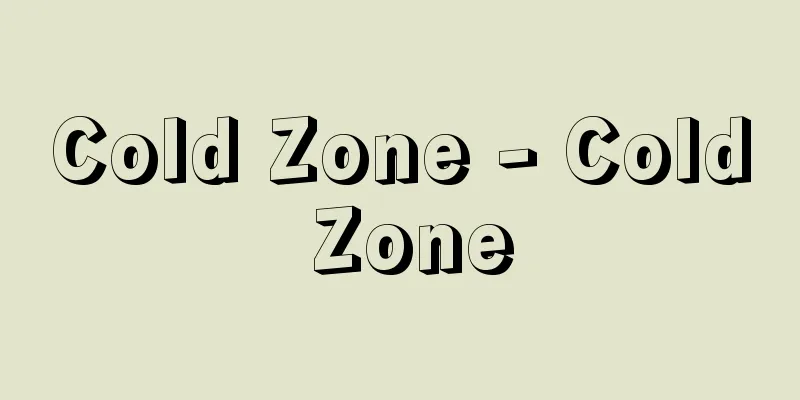Cold Zone - Cold Zone

|
The coldest region on Earth. It is the region on the pole side of the polar circle (66°33′). In terms of climate, it refers to the treeless region located on the pole side of the subarctic zone, and corresponds to the area where the average temperature of the warmest month is less than 10°C, based on vegetation. It is further divided into the tundra climate region, where the frozen soil melts temporarily due to the increase in solar radiation in summer, and where mosses and lichens grow, and the snow and ice climate region, where the land is covered with ice and snow all year round. In the Northern Hemisphere, it includes the far north of both Eurasia and North America, Greenland, and northern Iceland, and in the Southern Hemisphere, it includes Antarctica. It accounts for 17% of the total land area of the Earth, but it has the worst conditions for human life and activity, along with desert regions with little rain, and is sparsely populated and the least productive region on Earth today. The year is divided into a short summer and a long winter, and once you cross the polar circle, the sun never sets on the summer solstice, and does not rise all day on the winter solstice. Most of the precipitation falls as snow, and although the amount is small, the low temperatures mean that evaporation is also low, and the area is not as dry as a desert. The surface layer of permafrost, which is 300 meters deep, melts in the summer, turning the area into a wetland where mosses flourish. The only large animals that live in the tundra are reindeers. The moss populations that occur in these wetlands are also a famous feature of the tundra, and they sometimes stab reindeer to death in groups. Due to the lack of heat and light, agriculture is not possible, and indigenous peoples such as the Eskimos and Sámi have made a living by hunting and fishing. However, today the area is extremely important for underground resources such as oil fields, military and scientific research, and air routes. The area has also been strongly affected by global warming in recent years. [Shuji Yamashita] VegetationEcologically, the cold zone refers to the area around the poles where high and low forests cannot form due to the cold, and instead is dominated by dwarf shrubs and herbaceous tundra (a system of mosses, lichens, etc.), and includes the Arctic coastal regions of Eurasia and North America, Antarctica, and islands in the Antarctic Ocean. On the other hand, there is a theory that the areas around the Arctic and Antarctic are polar zones and should be distinguished from the cold zone because there is almost no vegetation there. There are about 400 species of plants distributed in the cold zone of the Northern Hemisphere, and in terms of quantity, they are mostly graminoid plants (plants with thin, hard leaves like those of grasses), such as the genera Caryophyllus and Carex. In the Antarctic, the main species are about 70 species of bryophytes and about 400 species of lichen. Note that the alpine zone is usually included in the cold zone. [Tatsuyuki Ohba] [References] | | | | | |Source: Shogakukan Encyclopedia Nipponica About Encyclopedia Nipponica Information | Legend |
|
地球上でもっとも高緯度にあって寒冷な地帯。極圏(66度33分)より極側の地域をいう。気候的には植生を指標として亜寒帯の極側に位置する無樹木地域をさし、最暖月の平均気温が10℃未満の地域に相当する。寒帯のなかでも夏の日射量の増加により一時的に凍土が融解して、蘚苔(せんたい)類や地衣類が生育するツンドラ気候地域と、一年中氷雪に覆われている氷雪気候地域に細区分される。北半球ではユーラシアと北アメリカ両大陸の極北部、グリーンランド、アイスランド北部などで、南半球では南極大陸が含まれる。地球上の全陸地面積の17%を占めているが、人間の生活や活動にとって、雨の少ない砂漠地方とともに最悪の条件を示し、今日でも人口希薄で、地球上でもっとも生産力の低い地域である。1年は短い夏と長い冬に二分され、極圏を越えると夏至では太陽が没することがなく、冬至には太陽は終日現れない。降水は大部分が雪として降り、量は少ないが、低温であるため蒸発量も少なく、砂漠のように乾燥はしていない。300メートルにも達する永久凍土層の表層が、夏季に融解して湿地となりコケ植物が繁茂する。ツンドラにおける唯一の大形獣はトナカイである。また、この湿原で異常発生するカの大群はツンドラの名物ともいわれ、トナカイを集団で刺し殺すこともある。熱と光が不足するため、農業は望めず、エスキモーやサーミなどの先住民は狩猟や漁労生活をしてきた。しかし、今日では油田などの地下資源や軍事、科学研究、航空路などにとって非常に重要な地域となっている。近年の地球温暖化の影響を強く受ける地域でもある。 [山下脩二] 植生生態学的に寒帯という場合は、極地周辺の寒冷のために高木林、低木林が成立せず、矮性(わいせい)低木と草本によるツンドラ(蘚苔(せんたい)、地衣などの群系)に占められる地域をいい、ユーラシアと北アメリカの北極海沿岸地方、南極および南極海の島が含まれる。一方、北極および南極周辺の地域は植生がほとんど存在しないため、極帯として、寒帯とは区別すべきであるとする説もある。北半球の寒帯に分布する植物は400種内外で、量的にはスズメノヤリ属、ノスゲ属などグラミノイド植物(イネ科植物状の葉が細くて硬い植物)が多い。南極では、70種内外の蘚苔類、400種ほどの地衣類がおもなものとなる。なお、普通は高山帯も寒帯に含める。 [大場達之] [参照項目] | | | | | | | |出典 小学館 日本大百科全書(ニッポニカ)日本大百科全書(ニッポニカ)について 情報 | 凡例 |
Recommend
Cambodian - Kambojjaago
It is the language of the Khmer people, mainly in...
Linhart, AT (English spelling) LinhartAT
...However, it was not until the 19th century tha...
Diabetes insipidus
Definition/Concept Vasopressin (AVP), an antidiure...
Greater London Council
…In France, 20 arrondissements are established in...
Perameles myosura (English spelling) Peramelesmyosura
...Marsupial [Yoshiharu Imaizumi]. . … *Some of t...
Wappa Rebellion - Wappa Ikki
In the early Meiji period, a peasant struggle for ...
Larix gmelini
A deciduous coniferous tree of the Pinaceae family...
William Styron
American author. Born in Newport News, Virginia, ...
Electric injury
…physiological changes caused by the flow of elec...
Euglena
… Euglena is a green, single-celled algae that gr...
Malakichthys wakiyai (English spelling) Malakichthyswakiyai
… [Kenji Mochizuki]. … *Some of the terminology t...
Radio-robot telemeteorograph
An automatic weather observation device that autom...
Lai Xingping - Rai Kyouhei
A Confucian scholar of the late Edo period. His g...
Blue-green grass - Blue-green grass
...The inflorescence is erect and appears spike-l...
Ven, J. (English spelling) VenJ
...When considering intersections, unions, etc., ...









